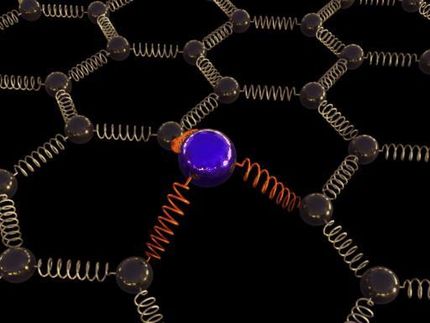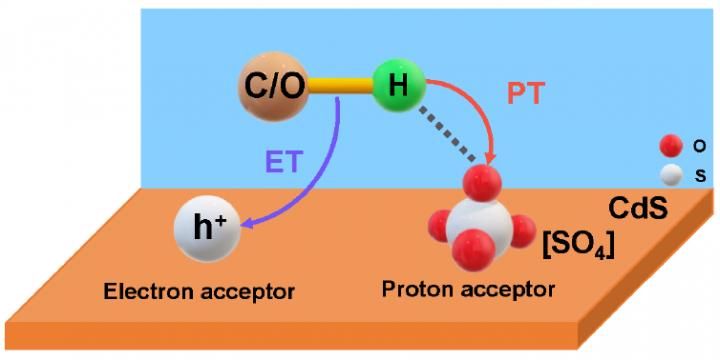In the focus of X-rays: New materials for the energy transition
New Process to Test Materials for the Hydrogen Industry
Researchers at the Deutsches Elektronen-Synchrotron DESY have developed a method to rapidly test new materials for the hydrogen industry and analyze their properties down to the atomic level. They were the first to test so-called high-entropy alloys for their corrosion resistance to hydrogen, and found that they may outperform the alloys commonly used in the industry.

Maxim Bykov and Konstantin Glazyrin at the beamline P02.2 at PETRA III
DESY
For the process, the researchers led by first author Konstantin Glazyrin primarily used the P02.2 and P61.2 beamlines at DESY's X-ray source PETRA III, which specialize in science under extreme conditions. There, they loaded powder samples of various alloys into a Diamond Anvil Cell (DAC) and exposed them to hydrogen under high pressure, which was introduced using a gas loader. They then used powder diffraction to precisely observe the interactions. In other words, Glazyrin used the high-brilliance X-rays from PETRA III to analyze the smallest structural changes in the polycrystalline material sample; these could be characterized using the diffraction patterns of the beams.
The team chose high-entropy alloys for their pilot study, characterizing the so-called Cantor alloy consisting of chromium, manganese, iron, cobalt, and nickel, as well as two alloys from the platinum group, which contain iridium, osmium, and ruthenium, among others. The Cantor alloys are considered promising materials for the storage of hydrogen in the energy sector if fossil fuels such as oil, natural gas, and coal are to be replaced by hydrogen in the coming years. Considering the alloys based on platinum group elements, those are equally important for catalytical applications, e.g. hydrogen production from water splitting.
High-entropy alloys are compounds consisting of at least five elements whose structure is very diverse - "disordered", so to speak - at an atomic level. Here, the term of "entropy" refers to the degree of disorder in a system. In recent years, materials scientists have increasingly recognized that high-entropy metal alloys and also ceramics are in many respects more efficient than conventional mixtures of fewer elements. Only with at least five elements homogeneously distributed in the material would it characterize as a high-entropy alloy. On atomic level, in terms of disorder, these alloys are more complex than, for example, conventional stainless steel which is an alloy of iron, carbon, and chromium.
"In these alloys the effect of entropy starts to play a role at the microscopic level," explains Konstantin Glazyrin. "Local environment of each atom is complicated by atoms of other kinds and their random distribution within the material. Our results suggest that for studied systems, the resulting electronic density is correlated with nano-strains induced by atomic disorder. It makes it more difficult for hydrogen atoms to diffuse into material and transform it into hydrides, which is the first step of corrosion." Corrosion by hydrogen - which is very similar to the rusting of metals through contact with water and oxygen – makes the material less durable over time.
Glazyrin has therefore investigated how the Cantor and platinum group alloys perform in comparison to conventional steel and beryllium copper alloys when they come into intensive and prolonged contact with hydrogen. Beryllium copper is often used in the hydrogen industry. It is chemically very resistant and does not produce any sparks, which is of course an advantage when dealing with highly flammable hydrogen. "However, beryllium compounds are often considered toxic and is therefore difficult to recycle," Glazyrin points out. For this reason alone, alternative materials are preferable.
The new alloys are non-toxic, easy to recycle and in the tests they proved to be significantly less susceptible to hydrogen corrosion at room temperature and increased pressure. "This advantage is difficult to quantify because it depends heavily on the operating conditions," admits Glazyrin. "In this pilot study, we were not able to investigate all possible conditions." However, the study could inspire other groups to carry out further and more specialized measurements. Considering the broad field of hydrogen economy, the study shows a great potential of high-entropy compounds for real-life applications. Cantor alloy among with other high-entropy alloys could be useful; for example, in form of a coating for systems in which hydrogen is produced, transported, or stored. "As with the engine components and fuel systems in our cars," says Glazyrin, "it should be important to us that such systems last as long as possible - not only for cost reasons but also for environmental reasons."
So far, not much is known about high-entropy alloys and their properties. They have only been researched for 20 years, and we are slowly uncover their full potential and tailor industrial processes to optimize for economic feasibility. However, as new breakthroughs are able to accelerate applied research in the fields which were not considered at the point of original discovery - new testing methods, similar to presented in the work of Glazyrin et al. can also provide a boost. "Our methodological development shortens the first steps of material characterization from weeks to days if not hours. Is your new material resistant to hydrogen? We can give a fast answer," says Glazyrin. The new methodology should also be safer than in conventional large-volume pressure chambers - and even tiny amounts of material samples are sufficient for meaningful results. Depending on a task, these factors could make the process considerably more cost-effective than conventional, comparable material tests.
"There is also the long-term perspective," adds Hanns-Peter Liermann, scientist in charge of the PETRA III beamline P02.2. " Apart from hydrogen economy, the German government is currently investing a lot of resources into research for nuclear fusion energy production, because renewable energy sources such as wind, sun, and water, are not always available requiring a backup power supplies and nuclear fusion could be such a source in the future." In nuclear fusion, the fusion of hydrogen into helium, releasing energy - a process that also takes place inside the sun. Unlike nuclear fission in nuclear power plants, it also produces hardly any highly radioactive waste. However, it does require a lot of hydrogen, which is converted under enormous pressure and temperature conditions. And the novel materials of 21st century, including high-entropy compounds, are also of interest for this purpose, for example, for lining the reactors. In order to test these materials we need facilities and instruments that are able to simulate the extreme conditions as well as the resulting effects, for example, at the walls of a fusion reactors: "Along with the proposed upgrade of PETRA III to PETRA IV in the coming years," says Liermann, "we are planning an extreme conditions beamline that can also be used for the in situ study of potential reactor wall materials." Targeted experiments to develop fusion reactor technology will then be possible.
In any case, new method developed by Glazyrin et al. has a great potential to speed up systematic search for new materials resistant to hydrogen. It is supplementing the ongoing efforts towards higher efficiency for hydrogen economy applications. The initial results on individual high-entropy alloys could be the first step towards further advanced development, but there is more to come. "With our basic research, we are creating the basis and starting point for new discoveries and applications," says Glazyrin. "We are steadily working on improvement of the tests and the auxiliary infrastructure. Our study is an international effort and may be interesting for potential partners from acdemia and industry."


































































